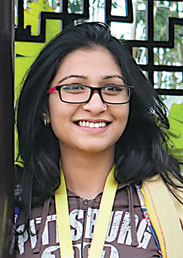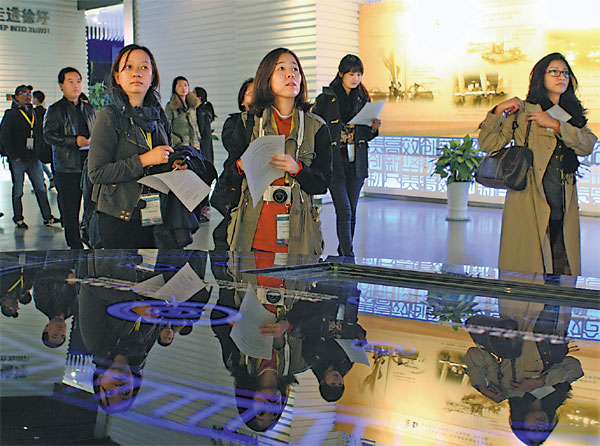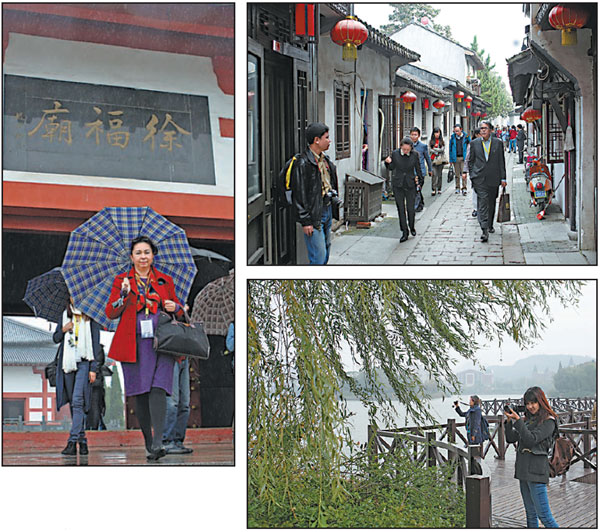Media inspired by Jiangsu journey

|
The media group visits the exhibition room of the Lianyungang Xuwei New Area. Photos by Wang Zhuangfei / China Daily |
|
Clockwise from above: Journalists visit Xufu Temple in Lianyungang, Liuhe town in Taicang and the park-like setting at Xuzhou Economic and Technological Development Zone. |
Eye-opening experiences show Asian journalists how urbanization and development mingle with history and culture
'The more I learn about China, the more I realize I don't know."-Erik Nilsson, China Daily.
He had said these words tome within the first few days of the Discover Jiangsu trip, a part of the Belt and Road Initiative, hosted by China Daily, for which I had come as a delegate and journalist of Bangladesh. Throughout the rest of the trip, this quote proved to be very true for me.
Jiangsu province has surprised me to no end. After landing in Nanjing, the first few glimpses of the provincial capital while going to the hotel were enough to strike me. The development and the uniformity of the architecture were impressive. But then, I didn't know what was coming up, and I wasn't prepared to be as pleasantly surprised as I was.
In Nanjing, located near the lower reaches of the Yangtze River and with a population of 8.2 million, we visited Nanjing University of Posts and Telecommunications, Suning Commerce Group, San-power Group, the new area in the north of Yangtze River, Nanjing port, all of which displayed the exciting development that Nanjing is now going through. The Zheng He Treasure Ship Heritage Park, which had the relics and replicas of the boats used for Zheng He's historic voyages, showed how history was still thriving.
In Xuzhou, located at the border of four provinces - Henan, Shandong, Jiangsu and Anhui - with a civilization dating back almost 5,000 years, we visited the Economic and Technological Developmental Zone, which showed us their intricate plans to urbanize the city. We visited the XCMG heavy machinery company, which had gifted road rollers to my country, Bangladesh, in the late 1980s. The group was vast and you could instantly tell that it was just a few steps behind Caterpillar, but with enough resources and strength to soon overtake the US company.
The Han Cultural Tourist Zone was an inspiring journey into history that really helped me understand the traditions and culture of China. The visit to Dragon Lake Park, surrounded with vibrant autumn colors, babbling brooks and a waterfall, was enough to persuade someone to make the city home.

When meeting with the city officials, I had even asked if they would increase tourism because Xuzhou is not something one can just know about. It is something one has to experience and feel. The excellent blend of urban and rural is evident in the high-rise buildings with a border of vast forest-covered mountains and hidden little huts and cottages.
Lianyungang, an important hub of the Eurasian continental bridge and a well-known seaport in China, was an integral part of the famous Chinese novel Journey to The West. Its four landscapes, the mountains, sea, islands and seaport, as well as three major ecological systems, interact in perfect harmony.
Suzhou, in the southeast part of Jiangsu and the central part of the Yangtze River Delta, is otherwise known as the "Venice of China"-and for good reason. The 100 celestial gardens and the Grand Canal running through it from North to South, leaves romance hanging in the atmosphere.
Suzhou can make the perfect scenic tourist city in China, where smiling is the local language and warmth is the general feeling. The 2,600-year-old Pinjiang Street is where time will slowdown just for you to look around and breathe history in, as you walk down the bricked road and visit little shops and stores with historic and modern artifacts alike.
We visited Hengtong group, which opened the first optical fiber manufacturing company in my country. The visit to Saint Joy silk company showed us the importance of the industry in China, as they not only supplied the apparel for the leaders at the APEC 2014, but also provided the silk for the wedding dresses of Kate Middleton, Duchess of Cambridge, and Princess Diana of Wales.
China Daily's hospitality and kindness was immeasurable and I thank it for everything it has done for us.
All in all, the whole trip was eye-opening as urbanization and development mingled beautifully with history and culture. The more I learned and the more I saw, the more I wanted to keep learning and seeing.
I can now, very confidently say, that China and I began a romance that is not ready to end anytime soon.
Naziba Basher is a reporter and feature writer for The Daily Star in Bangladesh.
(China Daily 12/07/2015 page8)










